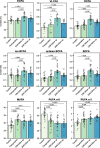Serum fatty acid profiles in breast cancer patients following treatment
- PMID: 37173619
- PMCID: PMC10176817
- DOI: 10.1186/s12885-023-10914-2
Serum fatty acid profiles in breast cancer patients following treatment
Abstract
Background: Breast cancer is associated with alterations in lipid metabolism. The treatment of breast cancer can also affect serum lipid composition. The purpose of this study was the examination of serum fatty acids (FAs) profiles in breast cancer survivors to assess if the FA levels normalize.
Methods: Serum levels of FAs were determined by gas chromatography-mass spectrometry in a group of breast cancer patients at baseline (before treatment, n = 28), at two follow-up visits at 12 months (n = 27) and 24 months (n = 19) after the breast cancer resection, and in the group of healthy controls (n = 25). Multivariate analysis was performed to assess how FA serum profile changes following treatment.
Results: Breast cancer patients' serum FA profiles at follow-ups did not normalize to the levels of control group. The greatest differences were found for levels of branched-chain (BCFA), odd-chain (OCFA) and polyunsaturated (PUFAs) FAs, all of which were significantly increased 12 months after the surgery.
Conclusions: After treatment for breast cancer, the patients' serum FA profile differs from the profile before treatment and from controls, especially 12 months after treatment. Some changes may be beneficial - increased BCFA and OCFA levels, and improved n-6/n-3 PUFA ratio. This may reflect lifestyle changes in breast cancer survivors and have an impact on the risk of recurrence.
Keywords: Breast cancer; Fatty acids; Gas chromatography-mass spectrometry; Lipids; Serum.
© 2023. The Author(s).
Conflict of interest statement
The authors declare no competing interests.
Figures





Similar articles
-
Radiotherapy improves serum fatty acids and lipid profile in breast cancer.Lipids Health Dis. 2017 May 18;16(1):92. doi: 10.1186/s12944-017-0481-y. Lipids Health Dis. 2017. PMID: 28521812 Free PMC article.
-
A comprehensive study of serum odd- and branched-chain fatty acids in patients with excess weight.Obesity (Silver Spring). 2016 Aug;24(8):1669-76. doi: 10.1002/oby.21560. Epub 2016 Jun 29. Obesity (Silver Spring). 2016. PMID: 27355152
-
Alterations in fatty acid metabolism in response to obesity surgery combined with dietary counseling.Nutr Diabetes. 2017 Sep 4;7(9):e285. doi: 10.1038/nutd.2017.33. Nutr Diabetes. 2017. PMID: 28869586 Free PMC article. Clinical Trial.
-
Nutritional enhancement of sheep meat fatty acid profile for human health and wellbeing.Food Res Int. 2018 Feb;104:25-38. doi: 10.1016/j.foodres.2017.05.005. Epub 2017 May 8. Food Res Int. 2018. PMID: 29433780 Review.
-
Monomethyl branched-chain fatty acids: Health effects and biological mechanisms.Prog Lipid Res. 2023 Apr;90:101226. doi: 10.1016/j.plipres.2023.101226. Epub 2023 Apr 23. Prog Lipid Res. 2023. PMID: 37094753 Review.
Cited by
-
Short leukocyte telomere length and high plasma phospholipid fatty acids increase the risk of type 2 diabetes.Endocr Connect. 2024 Oct 13;13(9):e240033. doi: 10.1530/EC-24-0033. Print 2024 Sep 1. Endocr Connect. 2024. PMID: 39045889 Free PMC article.
-
The influence of cancer on the reprogramming of lipid metabolism in healthy thyroid tissues of patients with papillary thyroid carcinoma.Endocrine. 2025 Jan;87(1):273-280. doi: 10.1007/s12020-024-03993-z. Epub 2024 Aug 15. Endocrine. 2025. PMID: 39145825 Free PMC article.
-
A Multiomics, Molecular Atlas of Breast Cancer Survivors.Metabolites. 2024 Jul 20;14(7):396. doi: 10.3390/metabo14070396. Metabolites. 2024. PMID: 39057719 Free PMC article.
-
Branched-Long-Chain Monomethyl Fatty Acids: Are They Hidden Gems?J Agric Food Chem. 2023 Dec 6;71(48):18674-18684. doi: 10.1021/acs.jafc.3c06300. Epub 2023 Nov 20. J Agric Food Chem. 2023. PMID: 37982580 Free PMC article. Review.
-
Metabolic Reprogramming of Phospholipid Fatty Acids as a Signature of Lung Cancer Type.Cancers (Basel). 2024 Sep 28;16(19):3320. doi: 10.3390/cancers16193320. Cancers (Basel). 2024. PMID: 39409945 Free PMC article.
References
-
- Sung H, Ferlay J, Siegel RL, Laversanne M, Soerjomataram I, Jemal A, et al. Global cancer statistics 2020: GLOBOCAN estimates of incidence and mortality worldwide for 36 cancers in 185 countries. CA Cancer J Clin. 2021;0(0):caac.21660. - PubMed
-
- Hendrick RE, Baker JA, Helvie MA. Breast cancer deaths averted over 3 decades. Cancer. 2019;125(9):1482–8. 10.1002/cncr.31954. [cited 2022 Feb 28] - PubMed
-
- Ng HS, Vitry A, Koczwara B, Roder D, McBride ML. Patterns of comorbidities in women with breast cancer: a Canadian population-based study. Cancer Causes Control. 2019;30(9):931–41. Available from: https://pubmed.ncbi.nlm.nih.gov/31280456/. [cited 2022 Mar 1] - PubMed
MeSH terms
Substances
Grants and funding
LinkOut - more resources
Full Text Sources
Medical
Research Materials
Miscellaneous

